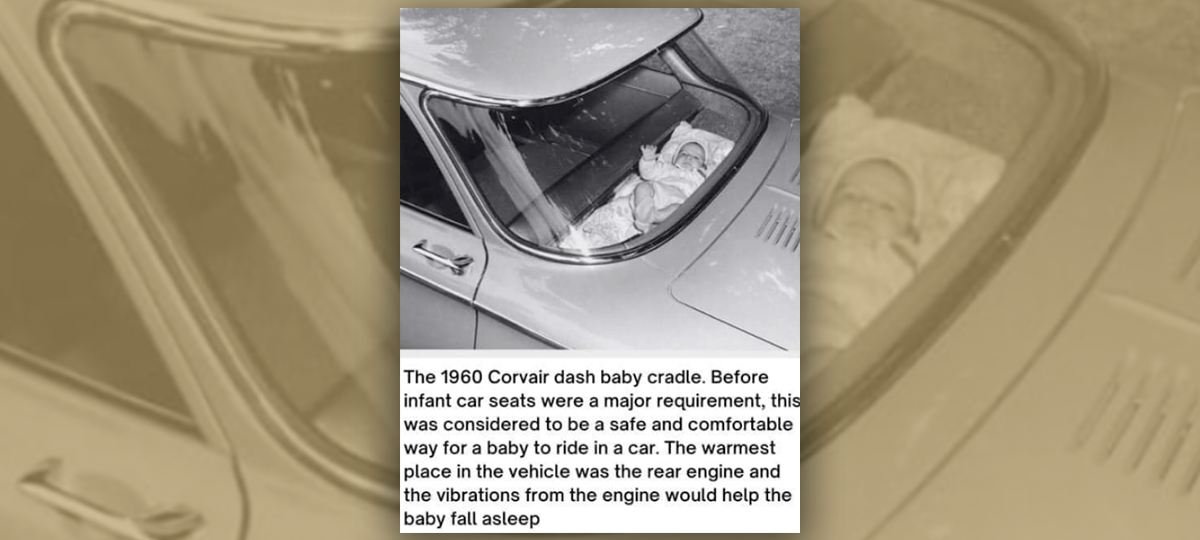Though some parents may have used the area behind the passenger seats of 1960s-era Chevy Corvairs as a place to stow a baby, this space was neither designed for, nor advertised for, that use.
A picture of a baby sleeping in the back of a Chevy Corvair has been described as a "dashboard baby cradle" since as early as 2014. This claim re-emerges frequently in tweets, Facebook posts, and other memes. A viral post on Reddit from late 2022, for example, describes the photograph this way:
The 1960 Corvair dash baby cradle. A safe, comfortable way to carry your baby before infant car seats were a major requirement. Warmest place in the car as it has a rear engine and the vibrations from the engine would lull the baby to sleep.
This statement echoes claims made in an ostensibly satirical post published sometime before December 2014. A post from that month on the website gmauthority.com makes several of the arguments that appear in the meme regarding baby cradles:
"Oh no," you say to yourself, "I have accommodated all that I needed to fit into my wonderful 1960 Chevrolet Corvair, but now there is no room for my beloved bundle of joy, 'Joseph.'" Don't you worry, daddy; it's a problem as old as time. That's why the brilliant engineers at Chevrolet have ingeniously crafted a first-in-class baby cradle into the dashboard! Incidentally, this is also a last-in-class.
From the comfort of his, shall we say, "exhilarating" perch, your baby will enjoy a second-to-none forward view of the road. And since the humble 80 HP engine is weaker than an asthmatic mule, you don't have to worry about your precious, fragile little human tumbling onto the floor under hard acceleration; there is none!
Worried about your baby's safety in the event that an abrupt stop is required? Don't be! While the momentum of your tiny sack of fresh blood and bone keeps him speeding forward across the dashboard, he will be safely retained by the standard, soft glass* windshield!
But wait! There are other perks, too! Flip on the windshield defrost and set your HVAC to hot to quickly warm your baby – because a warm baby is a happy baby! Never leave your attention-hungry human cargo out of your sight, as his diminutive little body obscures your forward view of the road! And with the optional automatic transmission, gear shifts are hands free, perfect for one-handed coddling of cute little Joseph while your other hand rests safely on the wheel!
It bears mentioning that the image does not show the dashboard of the Corvair, but instead shows the space behind the passenger seats.
Snopes has identified no newspaper ads or user manuals that make any claims about this space. Further, several experts on the Corvair told Snopes that the claims are largely nonsensical.
Eva McGuire, a historian and publicist for the Corvair Preservation Foundation and the National Corvair Museum, told Snopes by email that the claim has been around for a while, but does not represent a real product or marketing tactic:
I've seen this photo on the internet and circulating on Corvair Facebook pages for several years. There was never a baby cradle device made for the 1960 Corvair (or any other Corvair model year) by General Motors or available at any Chevrolet Dealership or aftermarket magazine/company. We do not know the origin of this photo and believe it was most likely taken by someone to show how roomy the rear storage space area was in a 1960 Corvair, and emphasized it by placing an infant in its cradle as a reference point. We think possibly someone else put that caption on this photo.
Realize, when the 1960 Corvair came out, it was a unique automobile. The trunk space was in the front, and additional storage space (i.e. used for luggage) was provided behind the rear seat. 1960 Corvairs, in particular, had a deeper rear storage area due to it having a gas heater in front. There may have been some Corvair owners who decided (on their own) to lay their babies or let their kids sit in the rear storage area, but it was never endorsed by GM or Chevrolet.
McGuire reached out to two other Corvair history experts on Snopes' behalf. One expert, Mike McKeel, told her that "the 1960 Corvair owners manual only made reference to this subject with a statement to this effect: Use caution when placing items in this area as to avoid them becoming projectiles in the event of a collision."
The other expert, Larry Claypool, "stated he never saw this photo appear in any automotive publications from back in the day when the 1960 Corvair came out i.e. Motor Trend, Road & Track, etc. He also stated that if this baby cradle device ever did exist, it would have appeared in the J.C. Whitney Catalog (and he never saw it there, either)."
Because the claim appears to have stemmed from a humorous post, has no contemporaneous documentation to support it, and is refuted by experts on the topic, we rank claims regarding a Corvair baby cradle as "False."

